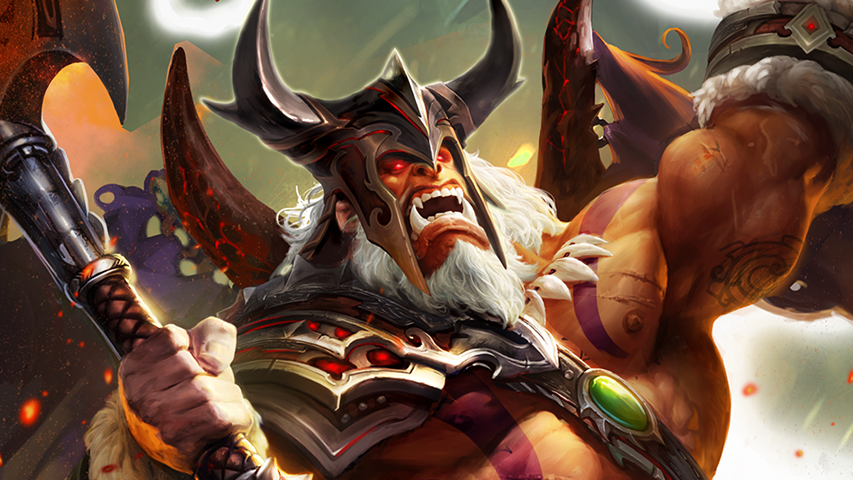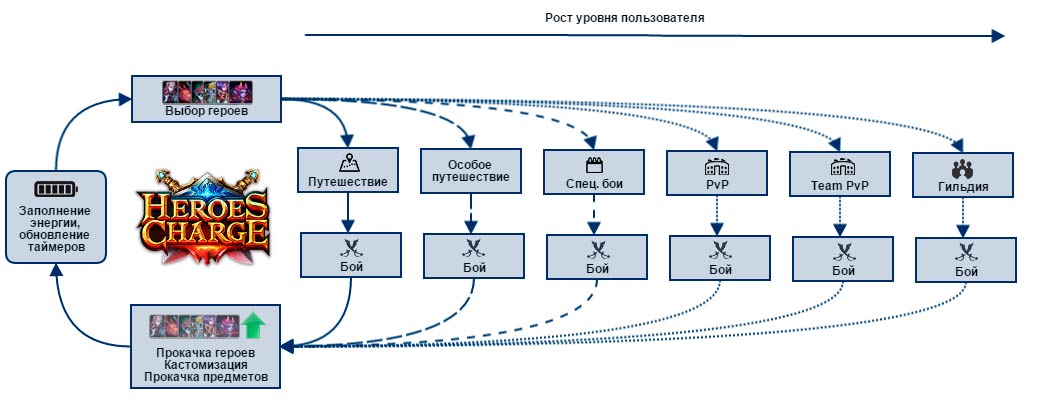Alexander Shtachenko talks about the basic game cycle, setting, energy system and motivational techniques in Heroes Charge in his material.
The article originally appeared on the pages progamedev.net , blog of Alexander Shtachenko. With the kind permission of the author, we publish it on our pages.
Dota heroes have come to life on mobile devices, fighting 5 on 5, demolishing packs of creeps, casting all the same skills. The setting is chosen so clearly that it falls into DOTA2’s 20 million audience (TI2014 statistics). After studying the mechanics of the game (spending almost $100), I put them together to assess the strengths and weaknesses of the feature. The set of composite mechanics collected in this game will not only replenish the list of a modern game designer, but also allow you to stock up on functionality to improve the performance of your application.
The positions of the game in the American gaming chartCore Game Loop
The basis of the game is a casual battle between heroes, creeps or bosses.
The number of fights per session is regulated by energy, counters and timer. At the beginning of the session, the player sets up a “peak”, selects a content branch and fights, earning coins and experience. After a series of fights, the player shakes the characters, improves things, spends the earned. As the game progresses, the user opens up more content, which he spends his time and money on. The more you play, the longer the session, more fights, more expensive new content.
Setting
I won’t waste time on the obvious. For those who do not know anything about Dota, I will say that this is a fantasy world with warriors, magic, dragons, who become stronger with each new victory, gain new skills. This setting is very popular in the world, and the target audience does not need training and introduction of characters. On the contrary, it motivates fans of this world to play.
Basic mechanicsAs in all card battles, the game is based on the mechanics of comparing a set of characters (cards) and their body kits (clothes).
The strongest wins. Around this battle mechanics, various ways have been created to push the player against other players and NPCs in a duel, but about everything in order.
Energy and meters
It is difficult to say that the energy was created here for the limitation of the session, because there is a lot of it and the sessions are about an hour +. However, if it didn’t end, I could play it non-stop.
There are 3 different limiters in the game, which are used to interrupt the session in different content branches of the game:
- Energy — there are 2 types and limits the following mechanics:
- Journey
- Excavations
- A limited number of fights per day limits:
- boss fights of the day (2 fights per day)
- two branches of different special duels per day (5 times a day)
- Arena and Super Arena fights (5 fights a day)
- Crusade (1 hike per day)
- Timer until the next fight — used so that the user has the opportunity to rest between fights. The average CD is 10 minutes.
It should be noted that energy and counters are not deducted if you lose in battle (except PvP). Thus, you can try to defeat a strong opponent indefinitely, which prolongs the session.
From Casual to Hardcore: the dynamics of content discovery in the game
At the beginning of the game, we are only invited to try the game mechanics to taste — to take a bite, so to speak. We have neither the needs nor the opportunities to dig into tuning, then be afraid of a complex mechanism of interaction.
Therefore, at first there are only 3 heroes at your disposal, one aptitude for each, and only one mechanic — “journey”. The balance of complexity does not require any super-pumping and farming.
As soon as the player is familiar with the simple rules of the game, they begin to change, it becomes more difficult. They add heroes to us, offer us to improve our abilities, and introduce us to new game mechanics.
As soon as there are more than 5 characters, the player is faced with a choice on which of them to spend their gold — on the main cast or evenly on all. At this moment, the PvP mode opens, in which the user can measure the size of an axe with their own kind. Immediately there is a need for farming, a desire to dress the team in full, get more experience.
Further, as the game progresses, it opens up additional components that can be conditionally divided into two types:
- mechanics for a variety of farming — so that it would not be boring
- mechanics to increase motivation to farm and swing — to keep the player more and more active
I will write about all these mechanics later.
Journey — as a driving mechanic
10+ locations have been drawn (12 and 13 are currently being completed). Each of the locations has 7 story battles. In the main mechanics of the journey, 2 intermediate battles are used. You will have to travel in 3 branches on the same content: Regular, Elite and Raid (you need a Guild, more on that later).
The game is made so that there is always a need to go through each location more than 100 times. The following techniques are used for this:
- collecting things to improve the hero in the “Normal Journey”. Different things fall out in different levels.
- collecting the name stones of the characters in the “Elite Journey”. Each level in the location corresponds to a unique stone.
- probabilistic loss of things (from 20% to 50% depending on the value of things) and stones (about 30%)
- the limit on the number of fights in the journey per day (for Elite, 3 for each level, for a Raid, only 2 for an open location)
If curiosity should be the main motivation to pass, then the desire to dress each hero to the maximum in order to dominate the Arena, Guild and Leaderboards motivates us to pass…
In this way, developers have learned to make money on a small amount of content an infinite number of times.
Conclusions from the first partWhen choosing a setting, you should evaluate its potential, calculate the approximate audience
- At the involvement stage, make the game as causal as possible, and only gradually, through midcore, turn it into a hardcore stud, with a total length of 5 hours of daily sessions
- Use mechanics that require the player to play the same content over and over again (read about it).
In the next part, I will detail the game mechanics and describe their strengths. We will talk about the mechanics of pumping characters, daily duels and sorenovaniyah between the heroes. The third part will have monetization, the mechanics of return and retention. Stay tuned.
A source: http://progamedev.net




